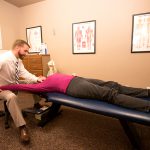The Importance of Chiropractic Care After a Car Accident
By: Dr. Daniel Welch
I provide chiropractic care after a car accident all the time at my office. There are significant range of complaints post trauma. Diagnosis has ranged from fractured ribs, post-concussion syndrome and even one clinical decapitation (that was an interesting CT scan).
It is my primary goal to properly diagnose the area, and determine the proper course of care warranted. Most of the time, a simple conservative care plan will last a few weeks, and life is back to normal. Sometimes chiropractic is not warranted, or it is necessary to co-manage with other professionals such as physical therapists, neurologists, or even psychologists and a personal injury lawyer. Prognosis is usually determined by a number of criteria, including but not limited to:
- Severity of the collision
- Type of collision,
- Size of vehicles involved
- Patient’s pre-existing baseline of health
- Patient’s adherence to the treatment plan
I am always surprised, though, to see the roll-over car accident injury case that resulted in just a mild strain; or a fender bender where I was forced to refer for a surgery consultation. The severity of the car accident is definitely not the only factor when determining if care is needed.
My Personal Experience with Injury After a Car Accident
Getting in a car accident is no fun. I can still remember my first (and only!) accident. It happened in my junior year of high school after I turned 16. I was rear-ended while sitting at a red light. I saw the accident coming, and everything went in slow motion. I had my head turned to the right, looking through my rear-view mirror. My car was struck by an old, heavy pick-up truck. My head, while turned to the right, was thrown forward. I braced my face from the steering wheel with my hands. I immediately felt a rush of adrenaline course through me. Although I was not at fault, my first thought was “my dad it going to kill me.” The guy behind me ran out of his car, apologized, and asked me to tell the cops his passenger was driving due to his suspended license. This was not a good sign.
I remember exiting my vehicle feeling sort of numb. The momentum of the collision had me bump the lady ahead of me, so I went to check on her. I started to access the situation, no leaking fuel, no missing limbs, it seemed everyone was going to be OK. I really wanted to just leave the situation and pretend it never happened, but luckily my few weeks at driving school gave me some prep. I called 911, reported the accident, and exchanged insurance information (with the lady ahead of me, the responsible citizen who rear-ended me had no insurance). Back then, cell phones were not a thing, but I luckily had a disposable camera in the glove compartment. Pictures of the impact to the cars were taken.
After the police arrived, I answered their questions, and drove to school. The rest would be handled by my parents, so I was off the hook. I felt a little headache and stiffness, but didn’t want to make a big thing out of it. I was supposed to play in the baseball game later that day and didn’t want to miss it by reporting some soreness. As the day progressed I became stiffer and had an increasing headache. My dumb 16-year-old self thought I should keep my mouth shut so I wouldn’t be forced to sit out. Well that was a mistake. (I played pretty terrible anyway.)
For the next few weeks, I would continue to get headaches and stiffness. I had difficulty concentrating or sleeping and didn’t know what was happening. I tried taking Advil, which took the edge off, but it was only temporary. My parents asked if I was OK, and I said I just felt tired. I developed a constant popping in my neck. I tried stretching more, but that seemed to make it worse.
Luckily, after about 6 weeks, the pain started to go away. I still had the annoying popping, but the headaches had reduced. I was out of the woods! Although I always felt stiff and would have to “crack my neck”, it would get better. Well that part didn’t. My posture never really came back. It was always easier to hunch forward, I just thought that was because I was tall.
Chiropractic Care After a Car Accident to Treat the Damages
Fast forward seven years I arrived at chiropractic school. I was getting examined by a fourth year intern due to increasing neck pain and stiffness. When he questioned if my neck muscles were always so tight, I said that they have been this way as long as I can remember. When he inquired if I have had any significant trauma, I said I don’t think so, but mentioned my car accident that I hadn’t thought about in years. X-rays were taken, and even my limited first year knowledge knew it wasn’t pretty. My cervical curvature was reversed, and I already showed signs of early stage degeneration. He hypothesized that the car accident initiated muscle spasms. This explained my acute neck pain for the first few weeks post car accident. When the pain diminished, I thought I was in the clear, but since my spine was never treated, it healed in a new comprised position. Years of sitting in class and sports allowed for the position to lock in causing a compensated posture. Although there was no pain during this phase, time was taking its toll with continued wear and tear.
Luckily for me, I started getting treatment and a rehab program. My neck feels better at 38 years old than it did at 22. I can’t rewrite all the damage done though, the curvature has not fully recovered, and the degeneration is still present. Like I tell my patients now, “you can fill a cavity, but will not fully get your previously healthy tooth back.” If I would have known better, a few weeks of conservative care with a chiropractor with some rehab exercises following my accident over 20 years ago would have gone a long way. It’s hard to reverse the effects of time.
To avoid pulling a 16-year-old Dan, go get checked out after a car accident. Even fender benders can leave more than a scratch when it comes to your spine.





